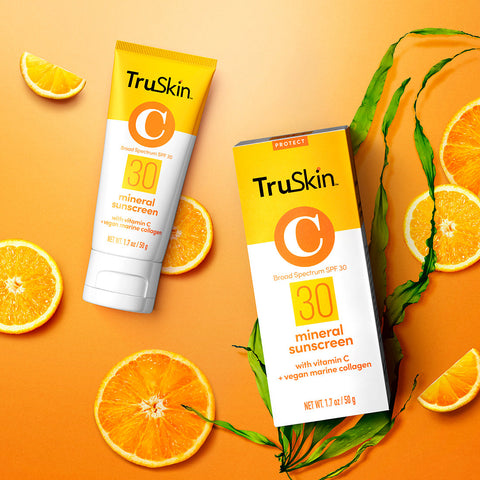
How To Up Your Skin’s Barrier Function Game
If you have sensitive skin, your best defense isn’t to overload it with a gazillion products in an attempt to ‘cure’ your sensitivities. Instead, it’s all about going back to basics to strengthen and care for your skin’s barrier function.
It's a fact, the uppermost layer of your skin really gets put through the mill. From constant cleansing through to the daily grind of heat, cold, sun, wind, pollution and central heating (need we go on?), its job to protect and defend your body comes under so much stress it’s a wonder it copes.
But that’s the thing: oftentimes, it doesn’t. And this is when problems like inflammation and flare-ups set in.
So, let’s have a look at the skin barrier to see what we can do to keep it at its very best, shall we?
What Exactly Is The Skin Barrier?
Your skin consists of three main layers. At the lowest level is the hypodermis (also known as subcutaneous tissue) which keeps your skin attached to your bones and muscle, supplies it with blood, and pads and insulates your body. Next, you’ll find the dermis which is where you’ll find your hair follicles, sweat glands, blood vessels and connective tissues. And at the very top is the protective layer, the epidermis, which serves primarily as a barrier to things like water, pollution, infection and damage.
The epidermis is split into many more layers but the uppermost layer is the one we’re concerned about here: the stratum corneum. Why? Because when we talk about your skin’s barrier function, the stratum corneum is where it all happens.
The stratum corneum is your body’s first line of defense and it works super hard to protect you from the environment and everything it throws at you. It’s kind of like a brick wall, built from around 20 layers of cells – although this is different for everyone and varies in certain areas of the body. These layers are made primarily of keratin, held in place by lipids such as ceramides, cholesterol and fatty acids. Together with your skin’s NMF (natural moisturizing factor) these work to keep the skin soft, supple, healthy and moisturized.
What Happens When Your Barrier Function Is Compromised?
Simple: if your stratum corneum is thin and/or weakened it won’t work as efficiently as it should to retain moisture and block out irritants. Cue dryness, dehydration and sensitivities such as itching, inflammation, redness, rashes and so on. And that's not all. Skin disorders like eczema, psoriasis and rosacea are also thought to be exacerbated or even triggered by an impaired skin barrier.
But why do some people have a weaker barrier function than others? Well, everyone’s skin composition is different (hello genetics), but there are a few factors to take into consideration when determining how strong and healthy your personal barrier function is. For starters, pale skin generally has a thinner stratum corneum than darker skin types which means its barrier doesn’t function as well and it’s more prone to irritation. Oh, and guess what? Your skin barrier weakens as you age, so while your skin might have been super strong and resilient in your 20s, by the time you hit your 30s this might no longer be the case. Aging. Ruthless.
5 Ways To A Better Skin Barrier Function
The good news is there are plenty of ways to care for your barrier function, strengthen your skin and therefore reduce sensitivities. Here are five simple ways to do all of the above.
1. Ditch The Harsh Cleansers
One of the worst things you can do for your skin’s barrier is to strip away all of its natural oils when washing your face. Be kind as you cleanse by using lukewarm, never hot water and choose your ingredients wisely. Surfactants like sodium laureth sulfate (SLS) and sodium lauryl ether sulfate (SLES) are often used in cleansers because they’re very good at cleaning the skin. But we think they’re a little too effective and this can end up leaving your barrier dry and compromised. This is why sulfates get a big no from us. Instead, look for gentler surfactants in your cleansers like disodium laureth sulfosuccinate and disodium 2-sulfolaurate. We use these in our cleansers as they’re known to be much kinder and way more skin-friendly than SLS and SLES.
2. Don’t Over-Exfoliate
As with the downsides of over-zealous cleansing, exfoliating your skin too much or too often can also damage your poor old stratum corneum. Skin cells have a life cycle of around 28 days in which time they form, mature and shed. This cycle often becomes sluggish and needs a little kick up the butt with things like exfoliation and chemical peels, but if you go too crazy you can end up causing more harm than good.
If you’re a fan of chemical peels, ask your derm to recommend the best frequency plan for your skin type and when it comes to at-home exfoliation? Replace super harsh scrubs that contain damaging particles like ground nut shells with gentle chemical exfoliators like lactic acid.
3. Embrace Antioxidants
Environmental stressors such as pollution and sun exposure are massive threats to the skin’s barrier function which is why we truly believe that protecting your skin is just as important as treating it well. Make sure you wear a daily, broad-spectrum sunscreen that has an SPF of 30 or above and never underestimate the powers of a good antioxidant serum to help counteract the damage caused by free radicals. Vitamin E and niacinamide are great options because they help repair barrier function and are tolerable by most skin types.

4. Boost Your NMF With The Right Ingredients
Your skin’s natural moisturizing factor (NMF) is a clever and very efficient way for your skin to keep itself naturally hydrated and healthy – but as you get older and subject it to the daily grinds of life, it needs help with some choice moisturizing ingredients.
Most derms and skin experts will tell you that ceramides are some of the most important ingredients for helping to up your NMF and restore your skin’s barrier. Ceramides are lipids that hold everything together in the stratum corneum but they’re greatly reduced by aging and environmental damage, so it totally figures that adding extras into your skincare routine will be beneficial in the long-term.
Similarly, humectants like hyaluronic acid, glycerin, aloe and urea are great ways to draw water into the skin, while emollient or occlusive ingredients like jojoba oil and colloidal oatmeal will seal it all in to help your barrier heal and repair itself.
5. Eat Well, Sleep Well & Try Not To Stress
This may be easier said than done but leading a healthier lifestyle in which you keep stress to a minimum, get eight hours of sleep and eat a balanced diet will go a long way in protecting and repairing your skin’s barrier from the inside out. Stress and lack of sleep have both been proven to weaken the skin’s barrier by slowing down its healing process, so do everything you can to be more zen and get your zzzs on a regular basis. This is important stuff, OK?
When it comes to what you eat, avoid refined carbs and sugars which are the devil and introduce more healthy fats such as omega-3 into your diet. Omega-3 is vital for a top dollar barrier function, so up your quota by eating more fatty fish like salmon and mackerel.
Finally, if your skin is causing you real concerns, it probably needs more help than you can offer it at home, so never hesitate to seek advice from a skincare professional. It may be that you’ve become intolerant to a certain ingredient in a product or become allergic to a specific type of food. And these are not things you can easily diagnose at home. Trust us, we've been there...









